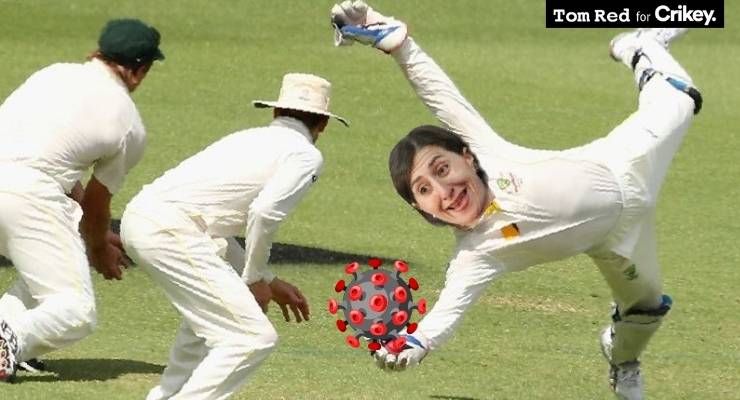
On Thursday, up to 12,000 sports fans are expected to file into the Sydney Cricket Ground (SCG) to watch Australia play India in the third Test.
Despite attendance numbers being cut to 12,000 from 24,000, experts remain deeply concerned about staging a potential super-spreader event while Sydney is in the middle of an outbreak.
It’s politically risky, too.
Leaders around the world have paid the price for misreading the public mood. Prime Minister Scott Morrison delivered Australia’s first example in March when he was forced to reverse his plans to attend an NRL game even as his government banned mass gatherings of more than 500.
‘Dangerous’ mixed messages
University of NSW epidemiologist Professor Marylouise McLaws tells Crikey the decision was “incredibly dangerous” and sent mixed messages on social restrictions.
“It’s a potential accelerant and makes no sense calling for mass COVID-19 testing while putting on a mass gathering,” she said.
“Even with a reduction in numbers, from an outbreak management perspective it’s nonsensical. You’re undoing all the good of mass testing and mandating masks.”
In greater Sydney, just five guests are allowed to visit a household. Weddings are capped at 100 guests, nightclubs have closed, and masks are mandatory in some indoor venues.
McLaws says the number of positive cases from tests in NSW is 0.06%. When adjusting for returned travelers in a crowd of 12,000, three to four people may be infected.
This morning NSW recorded four local COVID-19 cases.
Different social groups will mingle
Head of the epidemiological modelling unit at Monash University James Trauer tells Crikey the timing of the Test is a huge concern because the full effects of the holidays are not yet known.
“People have had Christmas with their extended family,” he said. “The virus incubates for the week, then people have associated with friend groups for New Year’s and social gatherings … before associating again in the workplace.”
Trauer says people from different postcodes and social groups will mingle.
“It’s got the potential to derail some of the progress made in NSW by getting people who wouldn’t normally be in contact with one another to mix,” he said.
“These broader associations have the potential to take small clusters and link them into extended chains of transmissions which will lead to extended outbreaks.”
Risks still not mitigated
The SCG will have a reduced capacity of 25%. Those who have visited COVID-19 exposure sites in the past 14 days will not be permitted entry. Masks are strongly recommended but not mandated.
The venue is broken up into eight sections, and attendees have to sit in their allocated section and row and have been asked to allow two seats between themselves and other groups.
La Trobe University epidemiologist Associate Professor Hassan Vally tells Crikey that although the new capacity limit eased some of his concerns, many logistical questions have not been answered: how attendees will enter and exit; how they’ll be stopped from mingling with the other seven sections while queuing at toilets and food stalls; can they socially distance themselves on public transport when going to and leaving the match?
Social distancing might go out the window if it rains and crowds huddle under shelters, he says.
“We’re in a situation where we’re pushing the odds,” he said. “If someone has COVID-19 [and] turns up [to the match] it’s really unlikely they won’t pass it on to other people.
“If the decision-makers are rolling the dice and willing to take the risk, and if the worst scenario happens — they clearly have to be accountable.”
He also wonders whether the decision to cut crowd numbers as cases tracked downwards was based on logic or a reaction to public pressure.
“If their logic was sound and based on evidence, what’s informed the change?” he said. “It makes you lose confidence in the process.”
Venues NSW chairman Tony Shepherd says the SCG has added extra security staff and social distancing marshals and has increased cleaning.
What’s the political fallout?
Leaders risk undermining the public’s trust if they have to later reverse policies they insisted were safe.
Whether or not the public believes the Test should go ahead, an outbreak at the SCG would trigger questions about NSW Premier Gladys Berejiklian’s decisions. So far she has managed to limit the spread of COVID-19 throughout the state but another major outbreak could quickly waste her political clout.
Has the NSW government made the right decision on the Sydney Test? Let us know your thoughts by writing to letters@crikey.com.au. Please include your full name to be considered for publication in Crikey’s Your Say column.









Gladys is a risk taker. She took significant risk with her Darryl relationship secret, she continued that by trying to play the Mills and Boon victim (she’s not, she’s a shrewd, calculating, clever, political operator), she doubled down by shredding papers for the grants rort (apparently a rort is not a theft, who knew?) of public money. Now she’s taking risks with lives. Let’s all hope she gets it right. If she doesn’t it’s more than a lost boyfriend and heaps of money, it’s peoples lives.
Irresponsible and senseless! No lessons learned from what went wrong in Victoria. Where is the NewsCorp outrage about placing citizens health and lives at risk?
ps and I am a cricket fan.
Obviously not. Play test with no spectators. Allowing spectators makes it look as if Gladys overly influenced by cricketing interests
Do we know who is/are lobbying for this crazy cricket game to go ahead with spectators at the stadium… are there political donations or other motivations behind this plan? Can anyone throw any light on this? Political risk and health risks seem disproportionately high.
Alan Jones was on the SCG Trust, not sure that is still the case. Alan Jones has expressed views that this Covid thing is a political beat up, while conveying a hasty retreat to his southern highlands castle to air his radio show, prior to retiring. Just saying.
What makes the public not trust our politicians is the mixed messages that are sent. This leads people think that it is really safe when it is not. Here in Western Australia, where we have had no community transmission for over 6 months, social distancing is still encouraged. The BBL cricket game I went to on Sunday had limited capacity and social distancing practices in place. The problem is these are only implemented within the stadium. Travelling to and from the venue people were literally crammed shoulder to shoulder on public transport cancelling the benefits of the expensive social distancing measures in the stadium. This will happen at the SCG as well. If the game goes ahead there should be no spectators.
NSW seems to the non decision making [lets see what happens then we will react] State unlike WA and Queensland – their populations are free to go about their private and commercial lives without fear their governments will chop and change with every other days announcements.
Look at the unfolding of the NSW cases – it is Victoria in slow motion – OOPs we have another cluster!
Gladys hasn’t once said anything about the health of individuals in her State – the message is that businesses should be able to work normally.